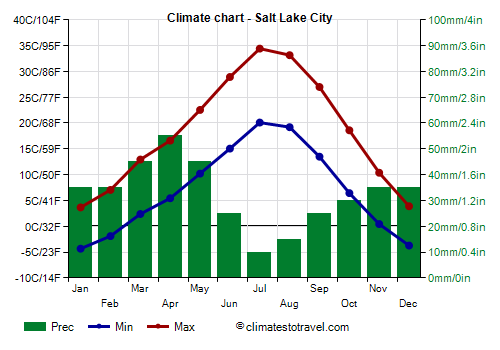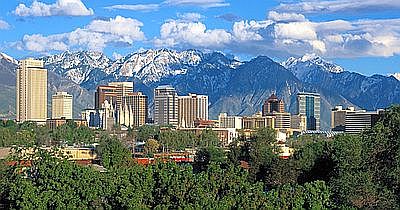Select units of measurement for the temperature and rainfall tables (metric or imperial).
Average weather, temperature, rainfall, sunshine hours

The climate of Salt Lake City is
continental, with cold winters and hot summers.
The city is the capital and largest city of Utah and is located at 1,300 meters (4,265 feet) above sea level in the so-called Great Basin, the arid plateau of the western United States.
Nearby is the Great Salt Lake, from which the city takes its name. To the east are
mountains, which are part of the Wasatch Range. The highest peaks visible from Salt Lake City are the Twin Peaks, which reach 3,453 meters (11,329 ft). The mountains are home to tourist resorts such as Snowbird and Park city. In 2002, Salt Lake City hosted the Winter Olympics.
At the foot of the mountains there is an urban area (called Wasatch Front) that also includes the cities of Ogden, West Valley City and Provo, near which there is a smaller lake, Lake Utah.
Instead, to the west we find the Oquirrh Mountains, which reach 3,235 meters (10,613 feet). Since the city is surrounded by mountains, the air tends to stagnate, especially in winter, and this causes pollution problems.
The
average temperature of the coldest month (January) is of -0.3 °C (31.4 °F), that of the warmest month (July) is of 27.3 °C (81.1 °F).
Precipitation amounts to 395 millimeters (15.5 inches) per year: it is therefore quite scarce. However, due to the proximity of the lake and the mountains, precipitation is more abundant than in other areas of the Great Basin, especially in the eastern districts of the city, at the foot of the mountains, where it reaches 555 mm (21.8 in) per year.
 Winter
Winter, from late November to early March, is very cold.
Snowfalls are frequent, and at times can be abundant. On average, 143 centimeters (56 inches) of snow fall per year. It usually snows from November to April.
Cold waves are intense, in fact, the temperature drops below 0 degrees Fahrenheit (-18 °C) almost every year. The record cold, -26.5 °C (-15.5 °F), was set in February 1984.
Having a very high salinity, the Great Salt Lake does not freeze even during the most intense cold waves.
However, there can also be short, fairly mild periods, with highs of 12/13 °C (54/55 °F) or more.
In periods of stable weather, fog can form.
Summer, from June to August, is hot and sunny, with rare afternoon thunderstorms.
The temperature range is often high, so it can be cool at night, but it can get very hot during the day. In addition, the rays of the sun at high altitudes are felt. Fortunately, the air is dry.
On the hottest days of the year, which sometimes occur in June, the temperature typically reaches 39/40 °C (102/104 °F). The record is 41.5 °C (106.5 °F), recorded in July 2002.
On average, there are around 3,030
sunshine hours per year. Therefore, the sun shines very often, especially from June to September, while in December and January it shines for less than half the time.
Best Time
To visit Salt Lake City you can choose the months of May and September.
In summer, during the hottest periods, you can take refuge in the mountains, perhaps bringing sunglasses, a sun hat and sunscreen.
Salt Lake City - Climate data
In Salt Lake City, the
average temperature of the coldest month (January) is of
-0.3 °C, that of the warmest month (July) is of
27.3 °C. Here are the average temperatures.
Salt Lake City - Average temperatures (1991-2020) |
| Month | Min | Max | Mean |
|---|
| January | -4.3 | 3.7 | -0.3 |
|---|
| February | -1.9 | 7.1 | 2.6 |
|---|
| March | 2.4 | 12.9 | 7.7 |
|---|
| April | 5.4 | 16.6 | 11 |
|---|
| May | 10.2 | 22.6 | 16.4 |
|---|
| June | 15.1 | 28.9 | 22 |
|---|
| July | 20.1 | 34.4 | 27.3 |
|---|
| August | 19.2 | 33.2 | 26.2 |
|---|
| September | 13.5 | 27 | 20.2 |
|---|
| October | 6.4 | 18.6 | 12.5 |
|---|
| November | 0.4 | 10.4 | 5.4 |
|---|
| December | -3.7 | 3.9 | 0.1 |
|---|
| Year | 7 | 18.3 | 12.6 |
|---|
amounts to
395 millimeters per year: it is therefore quite scarce. It ranges from
10 millimeters in the driest month (July) to
55 millimeters in the wettest one (April). Here is the average precipitation.
Salt Lake City - Average precipitation| Month | Days |
|---|
| January | 35 | 10 |
|---|
| February | 35 | 10 |
|---|
| March | 45 | 9 |
|---|
| April | 55 | 10 |
|---|
| May | 45 | 9 |
|---|
| June | 25 | 5 |
|---|
| July | 10 | 4 |
|---|
| August | 15 | 5 |
|---|
| September | 25 | 5 |
|---|
| October | 30 | 6 |
|---|
| November | 35 | 8 |
|---|
| December | 35 | 10 |
|---|
| Year | 395 | 91 |
|---|
There are on average around 3030
sunshine hours per year. Here are the average hours of sunshine per day.
Salt Lake City - Sunshine hours| Month | Average | Total |
|---|
| January | 4 | 125 |
|---|
| February | 6 | 165 |
|---|
| March | 8 | 240 |
|---|
| April | 9 | 270 |
|---|
| May | 10.5 | 320 |
|---|
| June | 12 | 360 |
|---|
| July | 12.5 | 380 |
|---|
| August | 11.5 | 350 |
|---|
| September | 10 | 300 |
|---|
| October | 8 | 250 |
|---|
| November | 5 | 150 |
|---|
| December | 3.5 | 115 |
|---|
| Year | 8.3 | 3030 |
|---|